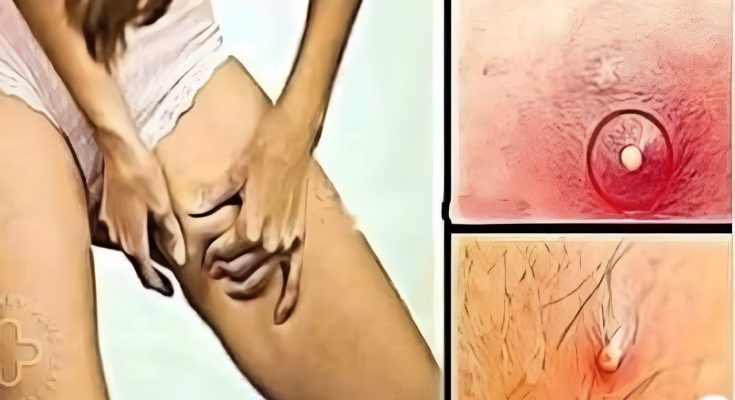Understanding Painful Skin Lumps in the Inner Thigh: Causes, Symptoms, and Treatment
Skin issues in sensitive areas such as the inner thighs or groin can be both painful and concerning. The image you’ve provided illustrates a common yet often misunderstood condition: the appearance of red, swollen lumps, sometimes filled with pus or fluid, that occur in areas where skin rubs together or where hair grows thick. These lumps can be caused by various factors, ranging from ingrown hairs to boils or infections of the hair follicles.
What Are These Lumps?
The lumps shown in the image are likely examples of one or more of the following skin conditions:
-
Boils (Furuncles):
Boils are painful, pus-filled bumps that form under the skin when bacteria infect and inflame one or more hair follicles. They often start as red, tender areas and quickly fill with pus, forming a white or yellow head. In the image, the right-side photos appear to show this classic presentation: red skin with a swollen, pus-filled center. -
Ingrown Hairs:
Ingrown hairs occur when a hair grows back into the skin instead of rising up from it. This often happens after shaving, waxing, or wearing tight clothing that causes hair to curl and re-enter the skin. The lower right section of the image may depict such a condition, with a visible hair beneath the skin’s surface and an inflamed bump surrounding it. -
Folliculitis:
This is an infection of the hair follicles, often caused by bacteria or fungi. It appears as small red or white-headed pimples around hair follicles and can sometimes develop into crusty sores. Folliculitis in the groin or thigh area is particularly common due to friction, sweating, and hair removal practices.
Causes and Risk Factors
These skin conditions can affect anyone but are more common in people who:
-
Frequently shave or wax their pubic or thigh area
-
Wear tight or synthetic clothing that traps moisture
-
Sweat excessively (which promotes bacterial growth)
-
Have a weakened immune system
-
Are overweight, as skin folds may increase friction and moisture
Poor hygiene, the use of contaminated towels or razors, and hot, humid climates can also contribute to the development of these infections.
Symptoms to Watch For
Common signs include:
-
Red, swollen lumps that are warm to the touch
-
Pain or tenderness in the affected area
-
Presence of pus or whiteheads
-
Itching or a burning sensation
-
In some cases, fever and fatigue (especially with larger boils)
If left untreated, a minor issue like an ingrown hair can escalate into a more serious infection.
Prevention Tips
-
Practice Good Hygiene: Bathe daily and after exercise. Use antibacterial soap if you’re prone to infections.
-
Avoid Tight Clothing: Wear breathable fabrics like cotton and avoid overly tight underwear or leggings that cause friction.
-
Shave Carefully: Use a sharp, clean razor, shave in the direction of hair growth, and consider trimming instead of shaving completely.
-
Exfoliate: Gently exfoliating the area can prevent hair from becoming trapped under the skin.
-
Stay Dry: Keep the area dry and cool, especially in hot climates.
Treatment Options
For mild cases:
-
Warm Compresses: Applying a warm cloth several times a day can help reduce swelling and encourage drainage.
-
Topical Treatments: Over-the-counter antibiotic ointments or acne creams containing benzoyl peroxide or salicylic acid can be effective.
-
Avoid Squeezing: Though tempting, do not squeeze or pop the lump as this can worsen the infection or cause it to spread.
For more severe or persistent lumps:
-
Medical Drainage: A healthcare provider may need to drain the boil or abscess.
-
Oral Antibiotics: Infections that don’t improve with topical treatment may require prescription antibiotics.
-
Medical Evaluation: Recurring boils or folliculitis may indicate an underlying health issue and should be evaluated by a doctor.
When to See a Doctor
Seek medical help if:
-
The lump is very painful or rapidly growing
-
You develop a fever
-
The area becomes hard or blackened
-
There is a foul-smelling discharge
-
The lump doesn’t improve within a few days
Conclusion
While skin lumps in the inner thigh can be uncomfortable and alarming, they are usually treatable with simple hygiene measures and over-the-counter care. Understanding the cause—whether it’s a boil, an ingrown hair, or folliculitis—is key to choosing the right treatment. When in doubt, always consult a healthcare professional for a proper diagnosis and safe treatment plan.




